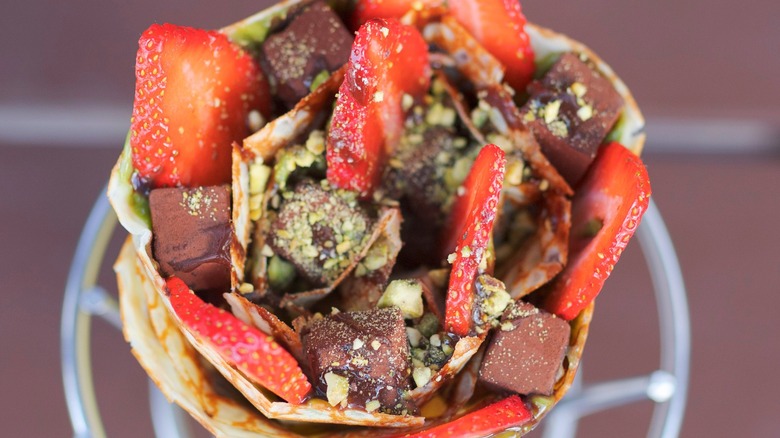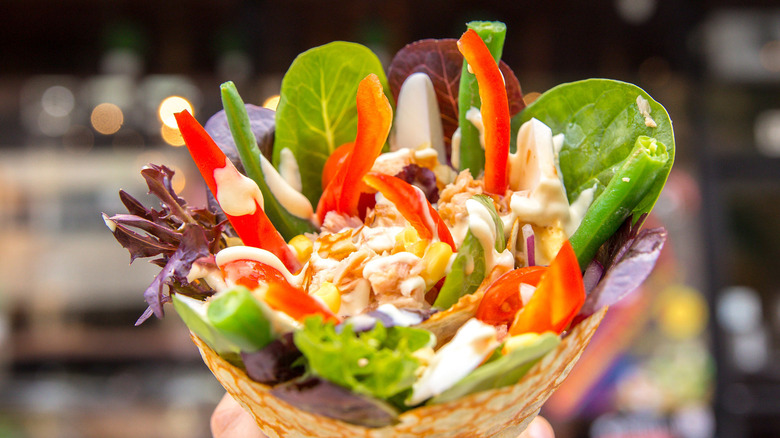The Difference Between Traditional French And Japanese Crepes
Imagine strolling through bustling New York City while relishing every bite of a crispy, delicate, gluten-free crepe — rolled up and brimming with cream, fruits, and a drizzle of chocolate. This is not your traditional, French, served-on-a-plate crepe, but a Japanese version, which is a portable and modern twist on the beloved delicacy. While the Japanese iteration retains the essence of its French counterpart, it introduces several novel elements.
In an exclusive conversation with Tasting Table, Jerry Lin, chef-entrepreneur and the co-founder of T-Swirl Crepe, America's leading Japanese crepe chain with 30+ locations nationwide, provides fascinating comparisons between French and Japanese crepes. Lin reveals, "While French crepes are tender, Japanese crepes are crispy on the outside while remaining soft and tender on the inside." The Japanese crepe also redefines the crepe experience; its unique texture allows for its transformation from a sit-down delicacy to an on-the-go treat. Let's dive deeper into this delicious culinary journey from France to Japan.
The universal appeal of French crepes
Originating in the 13th century from the Brittany region of northwest France, the French crepe has an endearing legend: it was a happy accident invented by a housewife who inadvertently spilled some thin porridge onto hot cookware. French crepes have since been globally recognized for their delicate tenderness, universal appeal, and versatility.
These days, French crepes are not made with porridge but with wheat flour, eggs, milk, and butter. The thin and runny batter is often swirled onto a hot, flat circular skillet or pan, spreading evenly to form a thin layer. As the crepe cooks, it curls and develops a light, golden color with a tender texture. A thin pancake, it's recognized as an adaptable canvas for an array of fillings — sweet delights like Nutella or peanut butter, fresh fruits, savory proteins, vegetables, and cheese. Traditionally enjoyed as a leisurely sit-down meal, these crepes are typically savored on a plate, and if done right, each bite is forked and eaten slowly and deliberately.
So what happens when this centuries-old delicacy collides with modern culinary innovation? The outcome is the emergence of the delightfully innovative Japanese crepe.
What sets Japanese crepes apart from French crepes
The Japanese crepe is a prime example of how a traditional dish can be adapted to suit modern lifestyles and curious palates. Lin elaborates, "A major difference ... is that Japanese crepes are made with rice flour instead of wheat flour." The substitution of rice flour makes this dish no less satisfying and suitable for those with gluten allergies and sensitivities.
And just like their French counterparts, Japanese crepes offer various fillings. Lin explained that "Japanese crepes can be sweet or savory" and that one of the T-Swirl Crepe fan favorites is the "Strawberry Bananacrepe which features fresh slices of strawberry and banana, luscious custard cream, tangy-sweet whipped yogurt, petite chocolate pearls, and crunchy crushed pistachio." For savory Japanese crepe ingredients, possibilities include "smokey bacon, crisp iceberg lettuce, hard-boiled egg, sweet grape tomatoes, creamy avocado, and crunchy shallots all smothered in chipotle aioli and sesame dressing."
Another feature that separates Japanese crepes is their form factor; they're rolled into a convenient cone shape or, if you like, a food bouquet that, as Lin attests, makes "them easy to hold, transport, and eat."
Japanese crepes are modern, highly-customizable, and here to stay
First-hand experience plays a pivotal role in the rising popularity of these innovative treats. As a popular street food across metropolitans like Tokyo and Seoul, you can often watch your highly-customized Japanese crepe come together every step of the way. The visual enticement of the assembly and presentation of the cone-shaped treat add to its appeal. It's also clear much thought has gone into making these convenient and portable, particularly appealing to consumers who plan to 'Gram on the go. Lin shares that "For take-away, we package each crepe in a clear conical bag with handles that protects, displays, and makes it easy to both carry and eat. For dine-in guests, we present our crepes in a metal cone which attractively displays them and makes it easy to eat and rest between bites."
From the fresh ingredients to the skillful preparation to its portability, it's clear why Japanese crepes have captivated a global audience and are here to stay, just like French crepes have done for centuries.



